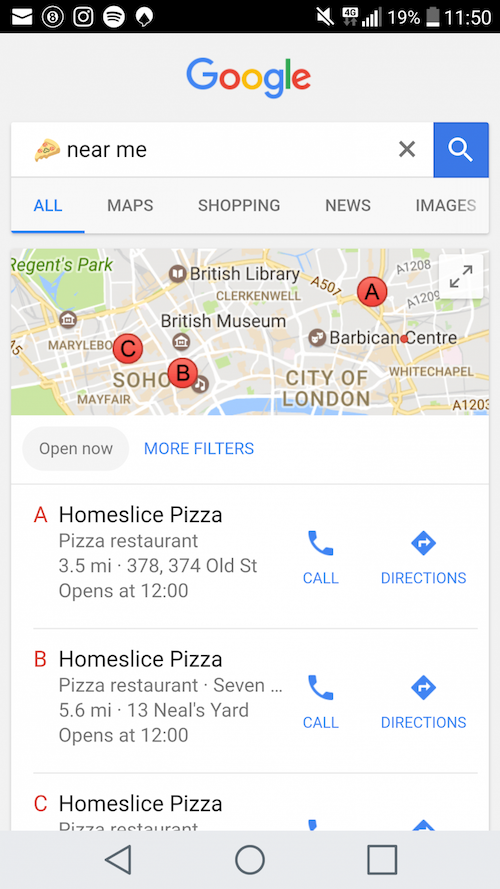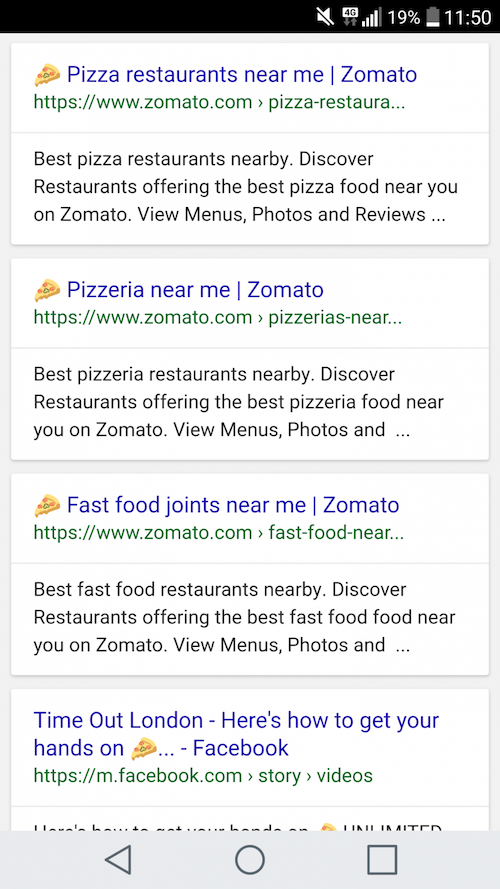Ben Austin Can Emojis Be Integrated Into Your Marketing Campaign? 59 Wow-Score The Wow-Score shows how engaging a blog post is. It is calculated based on the correlation between users’ active reading time, their scrolling speed and the article’s length. Learn more Can Emojis Be Integrated Into Your Marketing Campaign?
- 199
- 29
- 12
- 38
While you may have read the title of this blog post and thought “what a ridiculous idea,” the effect of millennials and Generation Z and how they use emojis could actually see a rise in emoji SEO – and this could be coming sooner than you might think. Can emojis be integrated into your marketing campaign? Quite simply, yes.
There are a number of things to suggest that Google is beginning to place more value on the emoji. Firstly, back in May 2016, Google re-allowed search by emoji, and Yelp, according to the Huffington Post, has been allowing emoji search since 2014, through its mobile app.
Google image search is another example of how emojis are slowly growing in importance, and with news that Google can also recognize emojis in any tweets that are sent to them, it is easy to see that the search engine is not only recognizing, but also rapidly indexing emojis.
Emojis In Marketing
If Google is beginning to index emoji-relevant results on SERPs, then SEOs are going to need to start thinking about how their client’s visibility could be affected by this evolution of emoji SEO.
Marketers are quickly beginning to jump on the emoji bandwagon, with reports suggesting that the use of emojis has grown by 775%. With a report from Adweek back in 2015 showing that 92% of online consumers use emojis, and with Millennials and Generation Z seemingly becoming more comfortable expressing their emotions through these little images as opposed to typing them out, it will be no surprise to see emojis begin to influence SERPs far more in the future.
This is similar to the way that slang and acronyms were incorporated into Google SERPs, where Google incorporated this in order to display the best results for user intent. Emoji SEO seems to be the next, most natural, transition.
How Emojis Can Be Used In SEO
Emojis in marketing campaigns are becoming a common sight, but where do emojis fit in with SEO and rankings? There are a number of different areas where they can be implemented:
- Local SEO
- Branded Search Terms
- City Search
Emojis In Local SEO
Local SEO is a hugely important factor for small businesses, and this new era of emojis could be set to change their online presence even further. Back in December 2016, Google launched their #KnowNearby campaign, where Google responded to Twitter users’ emoji tweets with the relevant search result and link.

This campaign helped Google to learn and understand over 200 different emoji symbols, while helping to relate to a particular thing. For example, if you tweeted @Google with a pizza emoji, it would bring up relevant search results for pizzas in your location. If you are searching within the browser/search engine itself as opposed to Twitter, an emoji of a pizza + ‘near me’ will also bring up relevant search results!
This is helping Google to explore more convenient, user-friendly options, and with the switch to mobile-first over the coming year, it’ll be no surprise to see more and more small businesses implementing emojis to help reach their nearby audience.
Google My Business
One of the ways that you can incorporate this into your Local SEO campaign is to look at your Google My Business profile. There is an increasing importance on the optimization of your Google My Business profile, and one way to help gain more exposure for your brand if users are searching for emojis, is to have a relevant emoji within your Google My Business profile.
Alternatively, if you have the pizza emoji featured somewhere on your site, you may see your map listing appear when someone makes a search.
This shows what appears on mobile when searching for emoji pizza symbol + ‘near me’, on Android:


The Purpose Of Emojis In SEO
The main reason for businesses to begin using emojis within their domain names, for page titles and for any other reason, is simply to stand out amongst the crowd within Google SERPs.
While this will benefit certain industries more than others — for example eCard websites, fun fashion and beauty blogs etc. — it really can help when it comes to click-through-rate. With Google looking ever more closely at user experience, click-through-rate is increasingly becoming an important factor when it comes to ranking highly on Google SERPs – and emojis could be the next step to help achieve this.
The emoji helps to better convey an expression and somewhat help to produce a deeper emotion, which can truly help readers to understand the context of what is being said. This helps to make your website even more relatable to users – generating a trust factor. If your page or blog post has an emotional element involved, then you should consider emoji optimization.
If your site is targeting common search terms, then you may want to consider using emojis within this in order to boost your site’s rankings for those using mobile in particular.
When we searched the ‘horse’ emoji + for sale, we discovered that all of the rankings that appeared were either sale sites, social media posts or videos. This provides a lot of opportunities for people to begin exploring ranking with emojis within their page title – as all of the rankings featured the emoji within the title, and sometimes in the meta description too.


Social media is going to be a huge influencer with emoji SEO, and with Google taking social signals into account even more with every algorithm update, this could be an easy way to help boost your site even more in emoji rankings. Include emojis with the updates that are relevant and topical, and you are likely to see more of an increase in success with emoji SEO.
How To Use Emojis In Your SEO Strategy
While emojis could be the next big thing in SEO and digital marketing, there is still a long way to go before emojis truly begin to take over. It is important to remember that, if you are considering using emojis in your marketing strategy, they should not be used as something to clutter your website with.
Use them sparingly within page titles, meta descriptions, Google My Business listing titles and AdWords ads. You want to make sure to only use them when the context of your page or post is truly relevant, emotive and high quality.
For example, you may want to consider using the phone emoji within your contact page, or a gift emoji for your sales or offers page. You can also use certain emojis during specific holiday periods such as Christmas, to help quickly attract user’s attention.
Dos and Don'ts
Cluttering your page titles, URLS and meta descriptions with emojis will make the link seem untrustworthy and spammy. You want to ensure emojis are used sparingly and only when highly relevant, particularly as the emoji is somewhat of a novelty as opposed to a fully useful search feature.
Incorporating emojis within your SEO strategy should be done in moderation, and while they may help to boost your CTR and increase the appeal of certain, relevant parts of your website, it is important that they are not solely relied on to boost your search rankings. However, this tiny little factor could really help your site’s visibility on Google, and with more people searching via mobile phone than ever, emoji SEO could be something we see taking off over the next few years.



